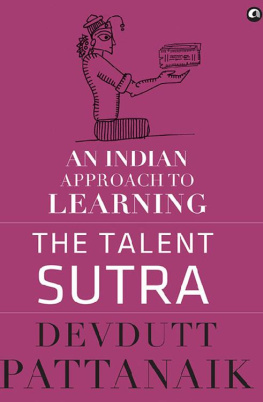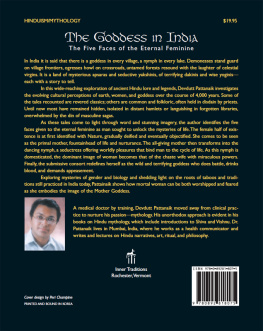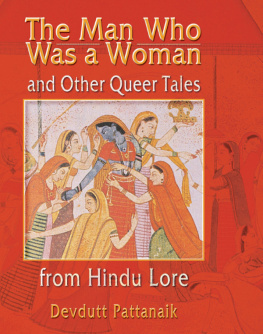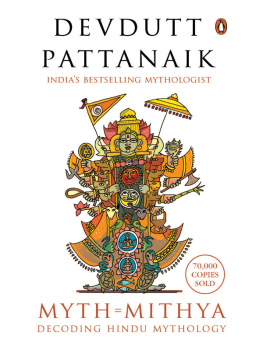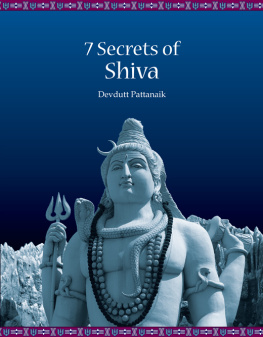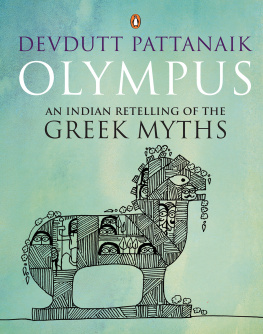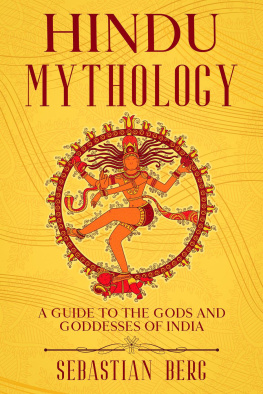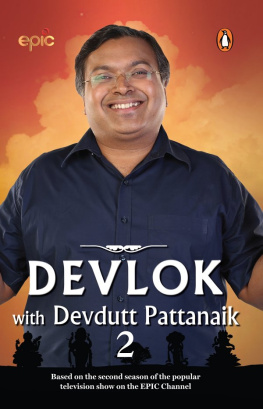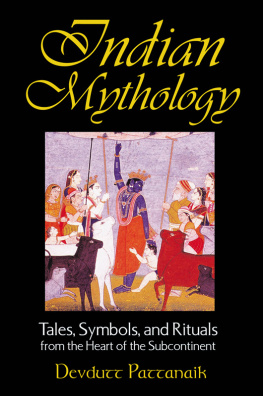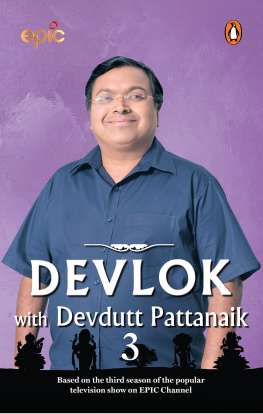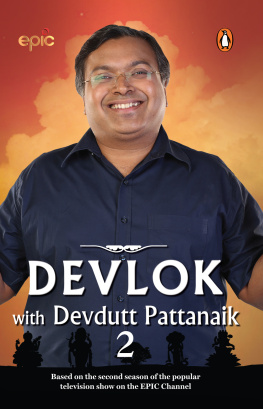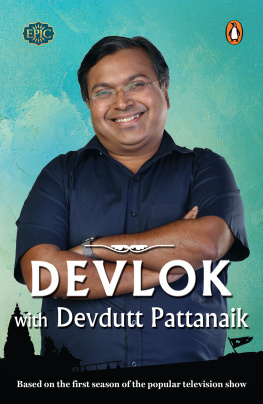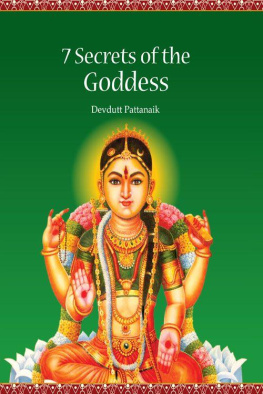SECRETS
FROM
HINDU
CALENDAR ART
Devdutt Pattanaik is a medical doctor by education, a leadership consultant by profession, and a mythologist by passion. He writes and lectures extensively on the relevance of stories, symbols and rituals in modern life. He has written over fifteen books, which include 7 Secrets of Hindu Calendar Art (Westland), Myth=Mithya: A Handbook of Hindu Mythology (Penguin), Book of Ram (Penguin), Jaya: An Illustrated Retelling of the Mahabharata (Penguin).
To know more visit devdutt.com
SECRETS
FROM
HINDU
CALENDAR ART

DEVDUTT
PATTANAIK

westland ltd
61, II Floor, Silverline Building, Alapakkam Main Road, Maduravoyal, Chennai 600095
93, I Floor, Shamlal Road, Daryaganj, New Delhi 110002
First e-pub edition: 2009
First published by westland ltd 2009
Copyright Devdutt Pattanaik 2009
All rights reserved
978-93-86224-02-6
Typeset and designed by Special Effects, Mumbai
This book is sold subject to the condition that it shall not by way of trade or otherwise, be lent, resold, hired out, circulated, and no reproduction in any form, in whole or in part (except for brief quotations in critical articles or reviews) may be made without written permission of the publishers.
I humbly and most respectfully dedicate this book to
those hundreds of artists and artisans who made
sacred art so easily accessible to the common man
CONTENTS
T he images in the book have been picked up from the street, from vendors who sit outside temples and sell their wares to pilgrims. Art historians have explained the origin of these images how artists like Raja Ravi Varma and the printing technology of the 19th century ensured that these illustrations reached almost every Hindu household across India, and how they came to dominate the visualisation of the common mans faith. In recent times, foreign tourists have been captivated by their supernatural content and gaudy colours. Fashion gurus have used them on the catwalk, incorporating them on apparel and accessories to get the attention of consumers, collectors and the media. But few have stopped to think about them where does this imagery come from? What are they saying? And, in ignorance, often innocence, sacred art has become fantasy art, used by some in ways that others consider disrespectful.
Attempts to explain the fantastic imagery are usually either defensive, apologetic or chauvinistic, as one tries to legitimise the content using logic or comparisons with other religions. Faith can never be scientific and words like sin and prophet do not help in understanding the worldview of Hindus.
To best appreciate Hindu art, one has to enter a new paradigm, a new way of explaining things. One has to explore new notions of perfection and possibility, quite different from the more familiar and more popular Greek, Biblical or Oriental worldviews. This book is an attempt to introduce the reader to this new paradigm.
The book consciously uses black and white renditions of the art so that the colours do not distract the reader from the content. Great attention has not been paid to the quality of the images as the point of the book is not the aesthetics of the image but the translation of this unique visual vocabulary created by our ancestors. I would have loved to list down and acknowledge each and every artist and printer; however, tracing them is virtually impossible since the images are not only mass-produced, but also constantly reproduced with minor changes by different artists; often, the same image is brought out by different printers.
Finally, like all things Hindu, the explanations in this book are just one of the many ways in which this art can be looked at. Read this book, keeping in mind:
Within infinite myths lies the Eternal Truth
Who sees it all?
Varuna has but a thousand eyes
Indra, a hundred
And I, only two.
Different people see God differently


Image 1.1
Shivas family
looks like a family photograph: father, mother and two sons. But this is no normal portrait. This is the image of a God called Shiva, a mountain mendicant, his wife, the Goddess Parvati, who is a mountain princess, and their two children, Ganesha, who has the head of an elephant, and Kartikeya, who holds a spear.
An outsider unfamiliar with Hinduism may find these images strange. How can someone have a river flowing out of his hair? How can anyone have an elephant-head and four arms? How can anyone ride a peacock? How can these be presentations of God? And how can there be so many Gods?
But Hindus are comfortable with these concepts because they have been raised with these images, accepting them without feeling the need to rationalise them. These are images of their faith, transmitted over generations. Through them, Hindus are introduced to the notion of the divine. The Hindu notion of the divine is unique. Unlike in Islam, it is given form, which can range from plants to animals to human beings. Unlike in Christianity, it is not restricted to a singular idea there are gods and goddesses, who are individually pieces of a jigsaw puzzle called God.
A story perhaps best explains this: One day, when this family was sitting together, they were paid a visit by a sage called Narad, who loved to stir trouble wherever he went.
I have a mango, said Narad, for your better son.
How can I decide which one is better? asked Shiva, turning to his wife, Parvati.
Let them go on a race, said Parvati. He who first goes around the world thrice shall get the mango.
Let it be so, said Shiva.

Image 1.2
Kartikeya

Image 1.3
The race
Kartikeya, shown in , quickly ran around his parents thrice and declared, I have won!
What do you mean, you won? asked Kartikeya. It was I who went around the world thrice. You just went around our parents.
Thats not true. You went around the world. I went around my world. Tell me, which world matters more?
The world is objective; my world is subjective. The world is rational and scientific; my world is intuitive and emotional. The world is global; my world is local. Both are truths but, as Ganesha asks, what matters more?
Every culture views the world through different lenses. For some, there is one formless divine; for others, the divine has many forms. Who is right? For some, there is only one life with no rebirth; for others, this is just one of many lives. Who is right? Answers to these questions are never universal. They are cultural. They spawn beliefs. From beliefs comes behaviour that can make us either less tolerant or more accommodating. That is why my world does matter.
Myth is an idea churned in my world; mythology is the set of stories, symbols and rituals that communicate a myth. Like the idea, the stories, symbols and rituals may seem absurd to the outsider, but will make perfect sense to the believer. is an example of this, as are the other images in this book. Each one makes sense to Hindus both in form and in content. They do not attempt to make sense to those who are not Hindus. They speak a language that is indifferent to rationality. And so, rivers spout from Shivas topknot and his son has an elephant head. A subject such as this must, therefore, be approached with empathy and a genuine spirit of curiosity, realising that these are windows to a cultures soul.
Next page

